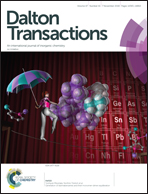Seven-coordinated iron(ii) spin-crossover molecules: some learning from iron substitution in [FexMn1−x(L222N3O2)(CN)2]·H2O solid solutions†
Abstract
The purpose of this work is to study the influence of the substitution of Fe(II) by Mn(II) on the spin crossover behaviour of [FexMn1−x(L222N3O2)(CN)2]·H2O solid solutions where L222N3O2 is a macrocyclic ligand = 2,13-dimethyl-6,9-dioxa-3,12,18-triazabicyclo[12.3.1]-octadeca-1(18),2,12,14,16-pentaene. The pure Fe(II) complex is known to present a change of the coordination number from 7 at high temperature to 6 at low temperature. The target of the solid solution study was to investigate the effect of metal dilution on this coordination change. We have then measured the thermal spin crossover features as well as the metastable HS state lifetime generated by rapid thermal quenching, which was probed through the determination of the T(TIESST) value. A discussion of the spin-state as a function of temperature is given based on the phase diagram of this series and based on the investigation of the crystal structure of the [Mn(L222N3O2)(CN)2]·H2O complex and its comparison with the published [Fe(L222N3O2)(CN)2]·H2O master compound.
![Graphical abstract: Seven-coordinated iron(ii) spin-crossover molecules: some learning from iron substitution in [FexMn1−x(L222N3O2)(CN)2]·H2O solid solutions](/en/Image/Get?imageInfo.ImageType=GA&imageInfo.ImageIdentifier.ManuscriptID=C8DT02517G&imageInfo.ImageIdentifier.Year=2018)


 Please wait while we load your content...
Please wait while we load your content...